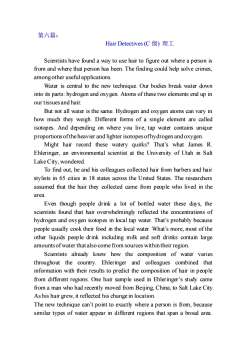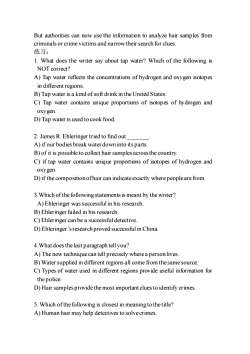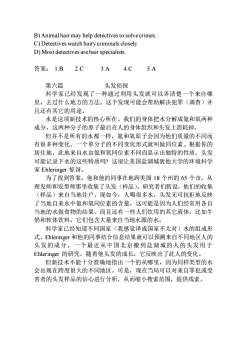《大学英语》课程参考资料(作文写作)Hair Detectives

第六篇:HairDetectives(C级)理工Scientists have found a way to use hair to figure out where a person isfrom and where that person has been. The finding could help solve crimes,amongother useful applications.Water is central to the new technique. Our bodies break water downinto its parts: hydrogen and oxygen. Atoms ofthese two elements end up inourtissues and hair.But not all water is the same. Hydrogen and oxygen atoms can vary inhow much they weigh.Different forms of a single element are calledisotopes. And depending on where you live, tap water contains uniqueproportions ofthe heavier and lighter isotopes ofhydrogen and oxygen.Might hair record these watery quirks? That's what James REhleringer, an environmental scientist at the University of Utah in SaltLake City, wondered.To find out, heand his colleagues collected hair from barbers and hairstylists in 65 cities in 18 states across the United States. The researchersassumed that the hair they collected came from people who lived in thearea.Even though people drink a lot of bottled water these days, thescientists found that hair overwhelmingly reflected the concentrations ofhydrogen and oxygen isotopes in local tap water. That's probably becausepeopleusually cook theirfood in the local water.What's more,most oftheother liquids people drink including milk and soft drinks contain largeamounts of water that also come from sources within their region.Scientists alreadyknewhow the composition ofwatervariesthroughout the country. Ehleringer and colleagues combined thatinformation with their results to predict the composition of hair in peoplefrom different regions. One hair sample used in Ehleringer's study camefrom a man who had recently moved from Beijing, China, to Salt Lake CityAshis hairgrew,it reflected his changein location.The new technique can't point to exactly where a person is from, becausesimilar types of water appear in different regions that span a broad area
第六篇: Hair Detectives (C 级) 理工 Scientists have found a way to use hair to figure out where a person is from and where that person has been. The finding could help solve crimes, among other useful applications. Water is central to the new technique. Our bodies break water down into its parts: hydrogen and oxygen. Atoms of these two elements end up in our tissues and hair. But not all water is the same. Hydrogen and oxygen atoms can vary in how much they weigh. Different forms of a single element are called isotopes. And depending on where you live, tap water contains unique proportions of the heavier and lighter isotopes of hydrogen and oxygen. Might hair record these watery quirks? That’s what James R. Ehleringer, an environmental scientist at the University of Utah in Salt Lake City, wondered. To find out, he and his colleagues collected hair from barbers and hair stylists in 65 cities in 18 states across the United States. The researchers assumed that the hair they collected came from people who lived in the area. Even though people drink a lot of bottled water these days, the scientists found that hair overwhelmingly reflected the concentrations of hydrogen and oxygen isotopes in local tap water. That’s probably because people usually cook their food in the local water. What’s more, most of the other liquids people drink including milk and soft drinks contain large amounts of water that also come from sources within their region. Scientists already knew how the composition of water varies throughout the country. Ehleringer and colleagues combined that information with their results to predict the composition of hair in people from different regions. One hair sample used in Ehleringer’s study came from a man who had recently moved from Beijing, China, to Salt Lake City. As his hair grew, it reflected his change in location. The new technique can’t point to exactly where a person is from, because similar types of water appear in different regions that span a broad area

But authorities can nowuse the information to analyze hair samples fromcriminals or crime victims and narrow their search for clues.练习:1. What does the writer say about tap water? Which of the following isNOTcorrect?A) Tap water reflects the concentrations of hydrogen and oxygen isotopesin different regions.B) Tap water is a kind of soft drink in the United States.C) Tap water contains unique proportions of isotopes of hydrogen andoxygen.D) Tap water is used to cook food.2.JamesR.Ehleringertriedtofind outA)if ourbodies break waterdown into its parts.B)of it is possible to collect hair samples acrossthe country.C) if tap water contains unique proportions of isotopes of hydrogen andoxygenD)if thecompositionofhair can indicateexactlywherepeoplearefrom.3. Which of the following statements is meant by the writer?A) Ehleringer was successful in his researchB) Ehleringer failed in his research.C)Ehleringer canbe a successfuldetectiveD)Ehleringer'sresearchprovedsuccessfulinChina.4. What does the last paragraph tell you?A) The new technique can tell precisely where a person lives.B) Water supplied in different regions all come from the same sourceC) Types of water used in different regions provide useful information forthepoliceD) Hair samples provide the most important clues to identify crimes.5. Which of the following is closest in meaningto thetitle?A)Human hair mayhelp detectives to solvecrimes
But authorities can now use the information to analyze hair samples from criminals or crime victims and narrow their search for clues. 练习: 1. What does the writer say about tap water? Which of the following is NOT correct? A) Tap water reflects the concentrations of hydrogen and oxygen isotopes in different regions. B) Tap water is a kind of soft drink in the United States. C) Tap water contains unique proportions of isotopes of hydrogen and oxygen. D) Tap water is used to cook food. 2. James R. Ehleringer tried to find out _. A) if our bodies break water down into its parts. B) of it is possible to collect hair samples across the country. C) if tap water contains unique proportions of isotopes of hydrogen and oxygen. D) if the composition of hair can indicate exactly where people are from. 3.Which of the following statements is meant by the writer? A) Ehleringer was successful in his research. B) Ehleringer failed in his research. C) Ehleringer can be a successful detective. D) Ehleringer’s research proved successful in China. 4.What does the last paragraph tell you? A) The new technique can tell precisely where a person lives. B) Water supplied in different regions all come from the same source. C) Types of water used in different regions provide useful information for the police. D) Hair samples provide the most important clues to identify crimes. 5. Which of the following is closest in meaning to the title? A) Human hair may help detectives to solve crimes

B)Animal hairmayhelpdetectivesto solvecrimesC)DetectiveswatchhairycriminalscloselyD)Mostdetectivesarehairspecialists4.C答案:1.B2.C3.A5.A第六篇头发侦探科学家已经发现了一种通过利用头发就可以弄清楚一个来自哪里,去过什么地方的方法。这个发现可能会帮助解决犯罪(调查)并且还有其它的用途。水是这项新技术的核心所在。我们的身体把水分解成氨和氧两种成分,这两种分子的原子最后在人的身体组织和头发上消耗掉。但并不是所有的水都一样,氨和氧原子会因为他们质量的不同而有很多种变化。一个单分子的不同变化形式就叫做同位素。根据你的居住地,此地来自水由氨和氧同位素不同而显示出独特的性质。头发可能记录下水的这些特质吗?这很让美国盐湖城犹他大学的环境科学家Ehleringer惊守。为了找到答案,他和他的同事在地跨美国18个州的65个市,从理发师和发型师那单收集了头发(样品2。研究者们假设,他们的收集(样品)来自当地住户。现如今,人喝很多水,头发无可抗拒地反映了当地自来水中氨和氧同位素的含量,这可能是因为人们经常用各自当地的水做食物的结果。而且还有一些人们饮用的其它液体,比如牛奶和软体饮料,它们包含大量来自当地水源的水。科学家已经知道不同国家(我感觉译成国家不太对)水的组成形式,Ehleringer和他的同事结合信息结果就可以预测来自不同地区人的头发的成分。一个最近从中国北京搬到盐湖城的人的头发用于Ehleringer的研究,随着他头发的成长,它反映出了此人的变化。但新技术不能十分准确地指出一个的从哪里,因为同样类型的水会出现在跨度很大的不同地区。可是,现在当局可以对来自罪犯或受害者的头发样品的信心进行分析,从而缩小搜索范围,提供线索
B) Animal hair may help detectives to solve crimes. C) Detectives watch hairy criminals closely. D) Most detectives are hair specialists. 答案: 1.B 2.C 3.A 4.C 5.A 第六篇 头发侦探 科学家已经发现了一种通过利用头发就可以弄清楚一个来自哪 里,去过什么地方的方法。这个发现可能会帮助解决犯罪(调查)并 且还有其它的用途。 水是这项新技术的核心所在。我们的身体把水分解成氨和氧两种 成分,这两种分子的原子最后在人的身体组织和头发上消耗掉。 但并不是所有的水都一样,氨和氧原子会因为他们质量的不同而 有很多种变化。一个单分子的不同变化形式就叫做同位素。根据你的 居住地,此地来自水由氨和氧同位素不同而显示出独特的性质。头发 可能记录下水的这些特质吗? 这很让美国盐湖城犹他大学的环境科学 家 Ehleringer 惊讶。 为了找到答案,他和他的同事在地跨美国 18 个州的 65 个市,从 理发师和发型师那里收集了头发(样品)。研究者们假设,他们的收集 (样品)来自当地住户。现如今,人喝很多水,头发无可抗拒地反映 了当地自来水中氨和氧同位素的含量,这可能是因为人们经常用各自 当地的水做食物的结果。而且还有一些人们饮用的其它液体,比如牛 奶和软体饮料,它们包含大量来自当地水源的水。 科学家已经知道不同国家(我感觉译成国家不太对)水的组成形 式,Ehleringer 和他的同事结合信息结果就可以预测来自不同地区人的 头发的成分。一个最近从中国北京搬到盐湖城的人的头发用于 Ehleringer 的研究,随着他头发的成长,它反映出了此人的变化。 但新技术不能十分准确地指出一个的从哪里,因为同样类型的水 会出现在跨度很大的不同地区。可是,现在当局可以对来自罪犯或受 害者的头发样品的信心进行分析,从而缩小搜索范围,提供线索
按次数下载不扣除下载券;
注册用户24小时内重复下载只扣除一次;
顺序:VIP每日次数-->可用次数-->下载券;
- 《大学英语》课程参考资料(作文写作)Medicine Award Kicks off Nobel Prize Announcements.doc
- 《大学英语》课程参考资料(作文写作)Online Cancer Chat with a Safety Net.doc
- 《大学英语》课程参考资料(作文写作)Road Trip Vacations.doc
- 《大学英语》课程参考资料(作文写作)Listening to Birdsong.doc
- 《大学英语》课程参考资料(作文写作)Light Night, Dark Stars.doc
- 《大学英语》课程参考资料(作文写作)Putting Plants to Work.doc
- 《大学英语》课程参考资料(作文写作)Mind-reading Machine.doc
- 《大学英语》课程参考资料(作文写作)Million Americans Suffer from Social Anxiety Disorder.doc
- 《大学英语》课程参考资料(作文写作)Surprised by a Miracl.doc
- 《大学英语》课程参考资料(作文写作)U.S. Scientists Confirm Water on Mars.doc
- 《大学英语》课程参考资料(作文写作)第四讲 提纲式.doc
- 《大学英语》课程参考资料(作文写作)第十讲 名言.doc
- 《大学英语》课程参考资料(作文写作)第十一讲 书信.doc
- 《大学英语》课程参考资料(作文写作)第六讲 对立观点即疑问句题目.doc
- 《大学英语》课程参考资料(作文写作)第八讲 解释原因.doc
- 《大学英语》课程参考资料(作文写作)第五讲 图表作文.doc
- 《大学英语》课程参考资料(作文写作)第二讲 段落构思.doc
- 《大学英语》课程参考资料(作文写作)第九讲 解决问题.doc
- 《大学英语》课程参考资料(作文写作)第三讲 段首句.doc
- 《大学英语》课程参考资料(作文写作)第七讲 利弊.doc
- 《大学英语》课程参考资料(作文写作)Declining Interest in Developing Foreign Language Skills.doc
- 《大学英语》课程参考资料(作文写作)Immigration and Problem.doc
- 《大学英语》课程参考资料(作文写作)Older Volcanic Eruptions.doc
- 《大学英语》课程参考资料(作文写作)Life Aichi University.doc
- 《大学英语》课程参考资料(作文写作)Calling for Safe Celebrations This Fourth of July.doc
- 《大学英语》课程参考资料(作文写作)U.S. to Start $3.2 Billion Child Health Study in January.doc
- 《大学英语》课程参考资料(作文写作)应试技巧-阅读理解.doc
- 《大学英语》课程试卷习题(大学英语四级【CET-4】历年真题大全,1989-2007年39套,含参考答案).docx
- 《大学英语》课程PPT教学课件(口语一)Unit Eight Holiday.ppt
- 《大学英语》课程PPT教学课件(口语一)Unit Five Calamites & Rescue.ppt
- 《大学英语》课程PPT教学课件(口语一)Unit Four Family love.ppt
- 《大学英语》课程PPT教学课件(口语一)Unit One Self-introduction.doc
- 《大学英语》课程PPT教学课件(口语一)Unit Seven Generation gap.ppt
- 《大学英语》课程PPT教学课件(口语一)Unit Six Music.ppt
- 《大学英语》课程PPT教学课件(口语一)Unit Three Cellphone.ppt
- 《大学英语》课程PPT教学课件(口语一)Unit Two Learning online.ppt
- 《大学英语》课程PPT教学课件(口语二)口语第七次.ppt
- 《大学英语》课程PPT教学课件(口语二)口语第六次.ppt
- 《大学英语》课程PPT教学课件(口语二)口语第九次.ppt
- 《大学英语》课程PPT教学课件(口语二)口语第二次.ppt
